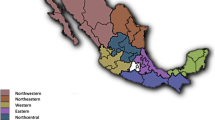Abstract
Cowdriosis, caused by Cowdria ruminantium, is transmitted by Amblyomma ticks, which are widely distributed in Zimbabwe. To assess the distribution of this disease in Zimbabwe, cattle either exposed to Amblyomma ticks or maintained in areas free from these ticks were tested for antibodies to Cowdria. A total of 324 sera were tested using competitive ELISA and the indirect fluorescent antibody test (IFAT). At diptanks in Amblyomma-infested areas 52% (n=95) and 26% (n=47) of sera were positive by cELISA and IFAT, respectively. At diptanks in Amblyomma-free areas 11% (n=125) and 10% (n=134) of sera were positive by cELISA and IFAT, respectively. The results were significantly different between Amblyomma-infested and tick-free areas (χ2=24.73, P≤0.005 for IFAT and χ2=57.53, P≤0.005 for cELISA). High background readings in field sera, possibly due to cross-reactive antibodies to Ehrlichia spp., complicated the determination of a realistic cut-off point, especially in cELISA. On the basis of the distribution of Amblyomma ticks, currently a large part of Zimbabwe can be considered endemic for the disease.
Similar content being viewed by others
References
AsselbergsA., JongejanF., LangaA., NevesL. and AfonsoS. 1993. Antibodies to Cowdria ruminantium in Mozambiquan goats and cattle detected by immunofluorescence using endothelial cell culture antigen. Trop. Anim. Hlth. Prod. 25: 144–150.
BirnieE.F., BurridgeM.J., CamusE. and Barre. 1985. Heartwater in the Caribbean: isolation of Cowdria ruminantium from Antigua. Vet. Rec., 116: 121–123.
DuPlessisJ.L., CamusE., OberemP.T. and MalanL., 1987. Heartwater serology: some problems with the interpretation of results. Onderstepoort J. Vet. Res., 54: 327–329.
DuPlessisJ.L. and MalanL., 1987. Problems with the interpretation of epidemiological data in heartwater: a study on 23 farms. Onderstepoort J. Vet. Res., 54: 427–433.
DuPlessisJ.L., BezuidenhoutJ.D., BrettM.S., CamusE., JongejanF., MahanS.M. and MartinezD., 1993. The serodiagnosis of heartwater: a comparison of 5 tests. Revue Élev. Méd. vét. Pays trop. 46: 123–129.
JongejanF., 1992. Serodiagnosis of Cowdria ruminantium: current status. In: Recent Developments in the Control of Anaplasmosis. Babesiosis and Cowdriosis: Proceedings of a Workshop held at ILRAD, Nairobi. Kenya. 13–15 May 1991. ed. T.T.Dolan. Nairobi, The International Laboratory for Research on Animal Diseases. pp. 67–77.
JongejanF. and ThielemansM.J.C., 1989. Identification of an immunodominant antigenically conserved 32-kilodalton protein from Cowdria ruminantium. Infect. Immun., 57: 3243–3246.
JongejanF., ThielemansM.J.C., DeGrootM., VanKootenP.J.S. and Van DerZeijstB.A.M., 1991. Competitive enzyme-linked immunosorbent assay for heartwater using monoclonal antibodies to a Cowdria ruminantium specific 32-kilodalton protein. Vet. Microbiol., 28: 199–211.
JongejanF., deVriesN., NieuwenhuysH., VanVlietA.H.M. and WassinkL.A., 1993. The immunodominant 32-kilodalton protein of Cowdria ruminantium is conserved within the genus Ehrlichia. Revue Élev. Méd. vét. Pays trop. 46: 145–152.
KockN.D., JongejanF., KockM.D., KockR.A. and MorkelP., 1992. Serological evidence for Cowdria ruminantium infection in free-ranging black (Diceros bicornis) and white (Ceratotherium simum) rhinoceroses in Zimbabwe. J. Zoo and Wildl. Med. 23: 409–413.
MahanS.M., TebeleN., MukwedeyaD., SemuS., NyathiC.B., WassinkL.A., KellyP.J., PeterT. and BarbetA.F., 1993. An immunoblotting diagnostic assay for heartwater based on the immunodominant 32 kD protein of Cowdria ruminantium detects false positives in field sera. J. Clin. Microbia., 31: 2729.
MartinezD., CoisneS., SheikboudouC. and JongejanF., 1993. Detection of antibodies to Cowdria ruminantium in the serum of domestic ruminants by indirect ELISA. Revuc Élev. Méd. vét. Pays trop. 46: 115–120.
MartinezD., SwinkelsJ., CamusE. and JongejanF., 1990. Comparaison de trois antigenes pour le séro-diagnostic de la cowdriose par immunofluorescence indirecte. Revue Élev. Méd. vét. Pays trop., 43: 159–166.
MatsonB.A., 1966. Epizootiology and control of tick-borne diseases of cattle in Rhodesia. Rhod. Agric. J., 63: 118–122.
Muller KoboldA., MartinezD., CamusE. and JongejanF. 1992. Distribution of heartwater in the Caribbean determined on the basis of detection of antibodies to the conserved 32-kilodalton protein of Cowdria ruminantium. J. Clin. Microbiol., 30: 1870–1873.
NorvalR.A.I., 1979. Tick infestations and tick-borne diseases in Zimbabwe Rhodesia. J. South Afr. Vet. Ass., 50: 289–292.
NorvalR.A.I., 1981. The ticks of Zimbabwe. III. Rhipicephalus evertsi evertsi. Zimbabwe Vet. J., 12: 31–35.
NorvalR.A.I., 1982. The ticks of Zimbabwe. IV. The genus Hyalomma. Zimbabwe Vet. J., 13: 2–10.
NorvalR.A.I., 1983. The ticks of Zimbabwe. VII. The genus Amblyomma. Zimbabwe Vet. J., 14: 3–18.
NorvalR.A.I., AndrewH.R. and YunkerC.E., 1990. Infection rates with Cowdria ruminantium of nymphs and adults of the bont tick Amblyomma hebraeum collected in the field in Zimbabwe. Vet. Parasitol., 36: 277–283.
NorvalR.A.I., PerryB.D. and HargreavesS.K., 1992. Tick and tick-borne disease control in Zimbabwe: what might the future hold? Zimbabwe Vet. J., 23: 1–15.
PerreauP., MorelP.C., BarreN. and DurandP., 1980. Existance de la cowdriose a Cowdria ruminantium chez les petits ruminants des Antilles Francaises (La Guadeloupe) et des Mascareignes (La Reunion et Ile Maurice). Revue Élev. Méd. vét. Pays trop., 33: 21–22.
SemuS.M., MahanS.M., YunkerC.E. and BurridgeM.J., 1992. Development and persistence of Cowdria ruminantium specific antibodies following experimental infection of cattle, as detected by the indirect fluorescent antibody test. Vet. Immunol. Immunopathol., 33: 339–352.
UilenbergG., 1983. Heartwater (Cowdria ruminantium infection): current status. Adv. Vet. Sci. Comp. Med., 27: 427–480.
UilenbergG, BarreN., CamusE., BurridgeM.J. and GarrisG.I., 1984. Heartwater in the Caribbean. Prev. Vet. Med., 2: 255–267.
YunkerC.E. and NorvalR.A.I., 1991. Heartwater disease of ruminants in Zimbabwe: current research and prospects for control. Modern Acarol., 1: 229–232.
Author information
Authors and Affiliations
Rights and permissions
About this article
Cite this article
de Vries, N., Mahan, S.M., Ushewokunze-Obatolu, U. et al. Correlation between antibodies to Cowdria ruminantium (Rickettsiales) in cattle and the distribution of Amblyomma vector ticks in Zimbabwe. Exp Appl Acarol 17, 799–810 (1993). https://doi.org/10.1007/BF00225853
Accepted:
Issue Date:
DOI: https://doi.org/10.1007/BF00225853




